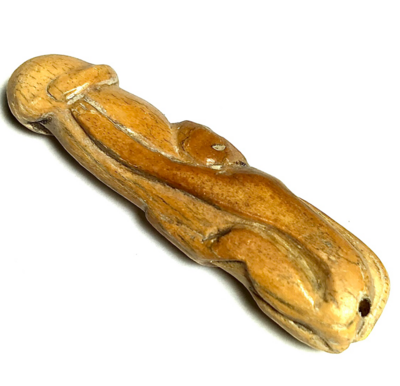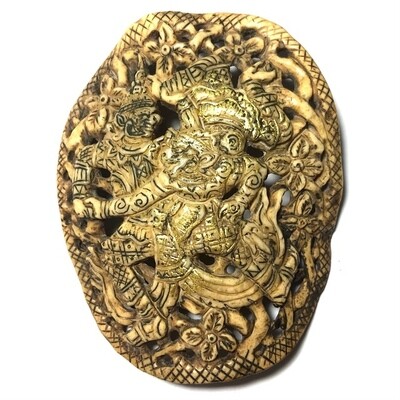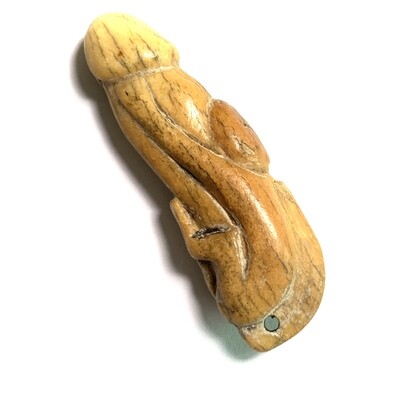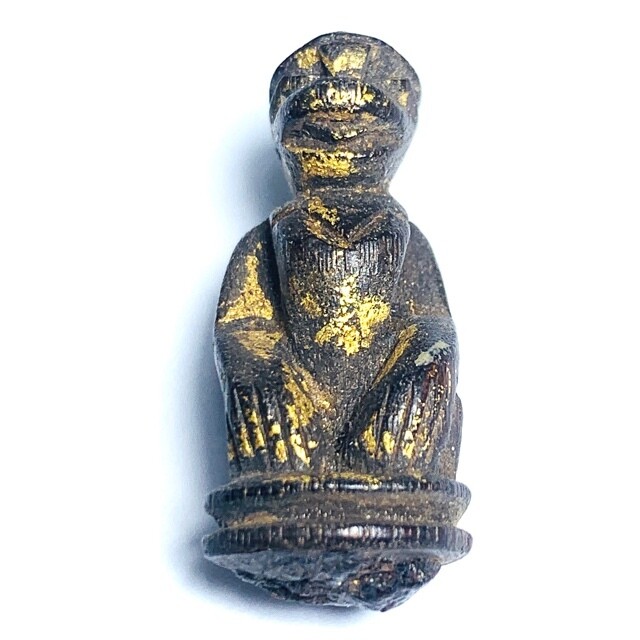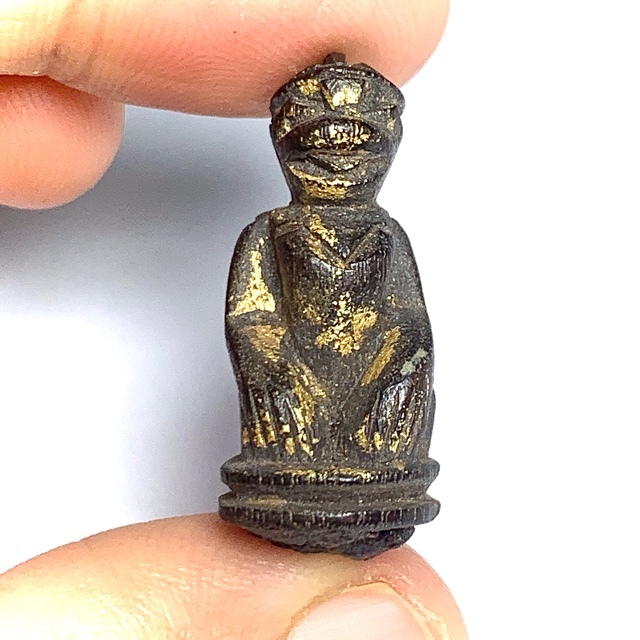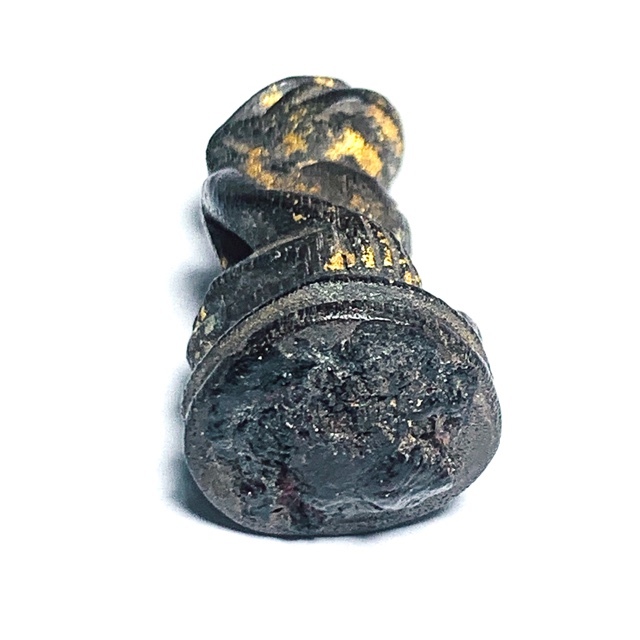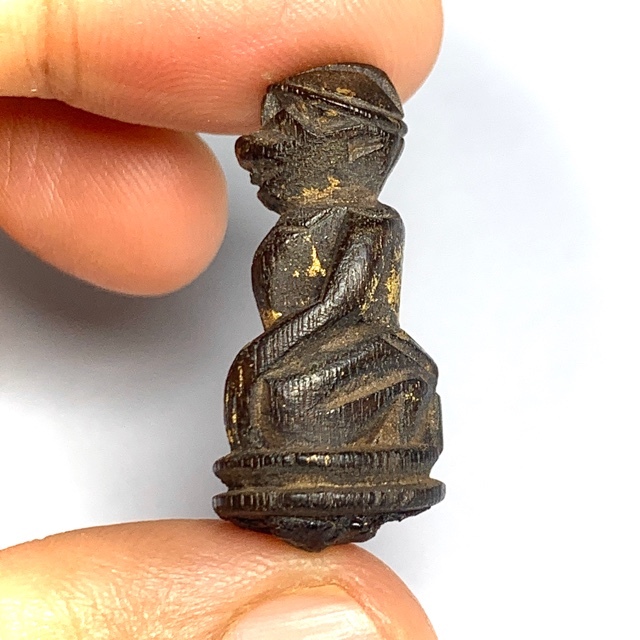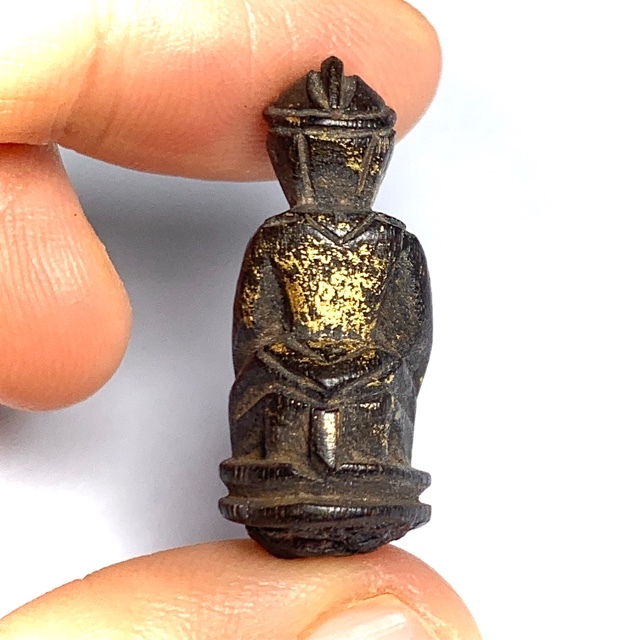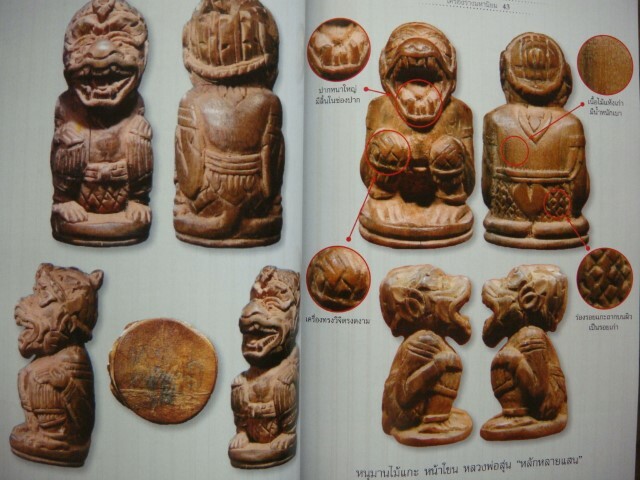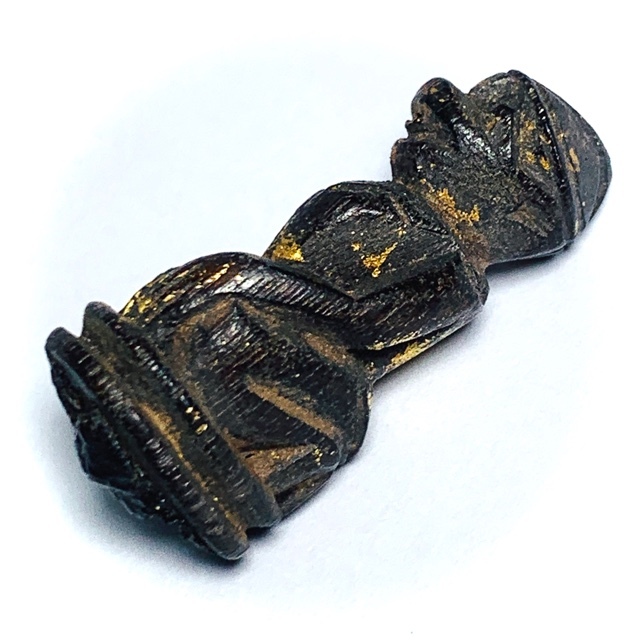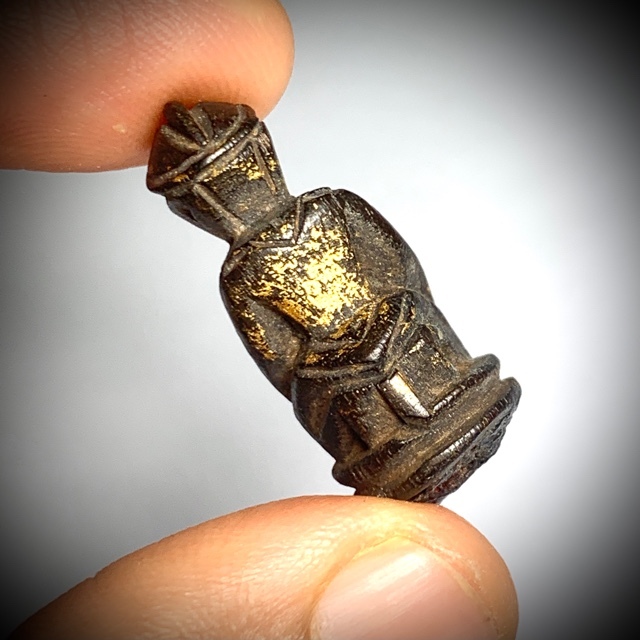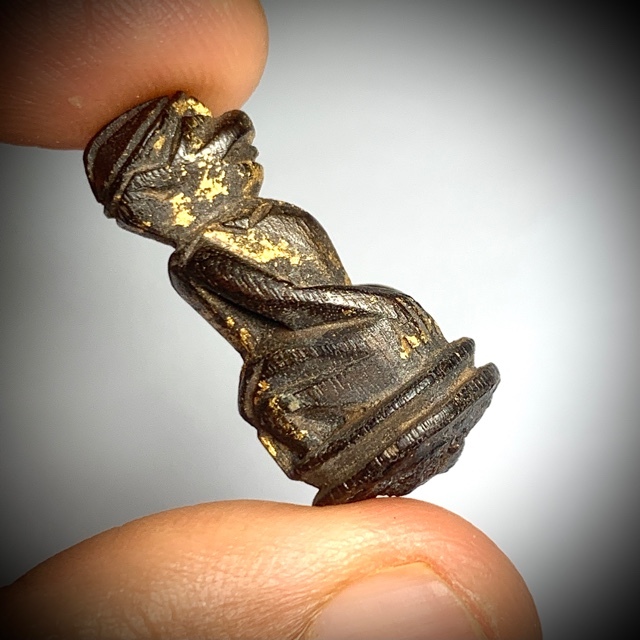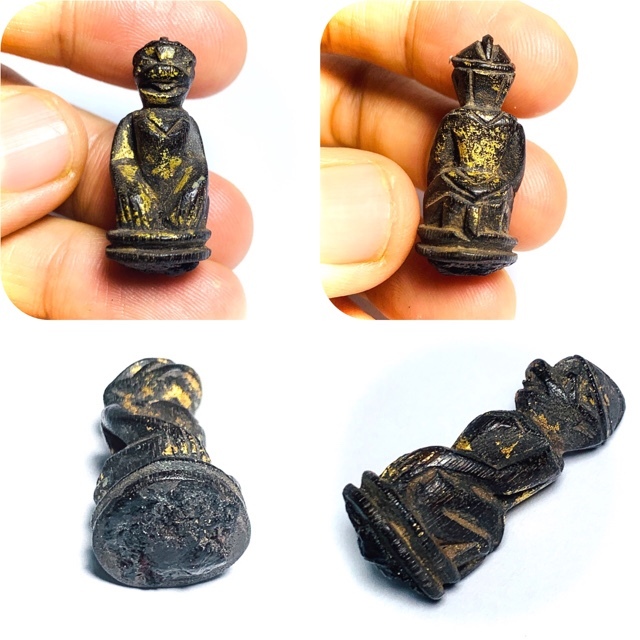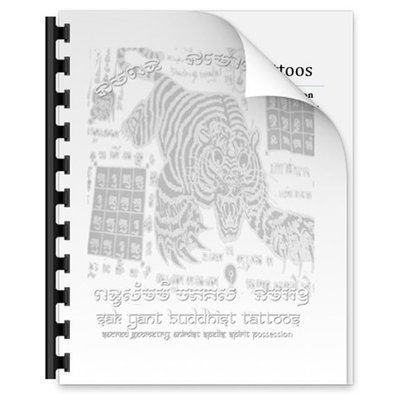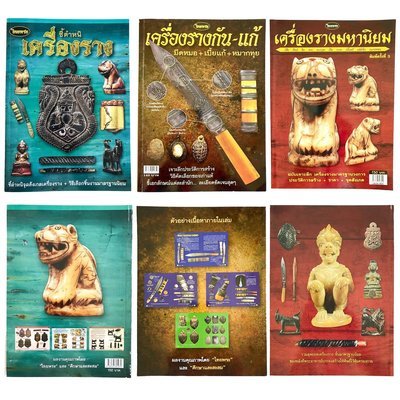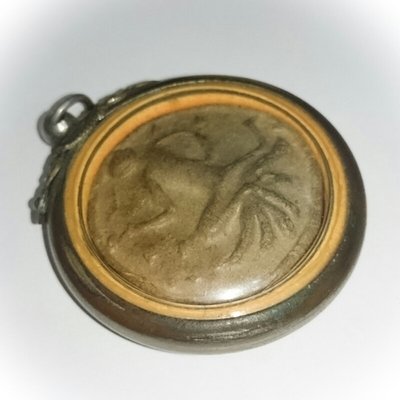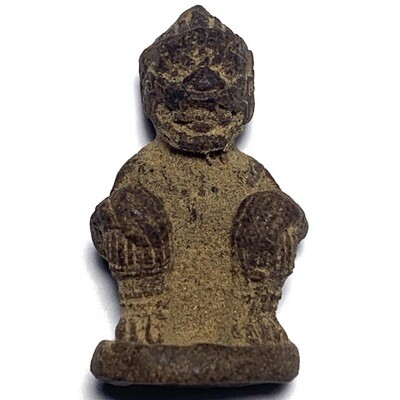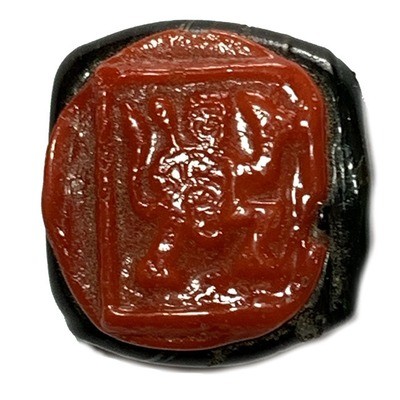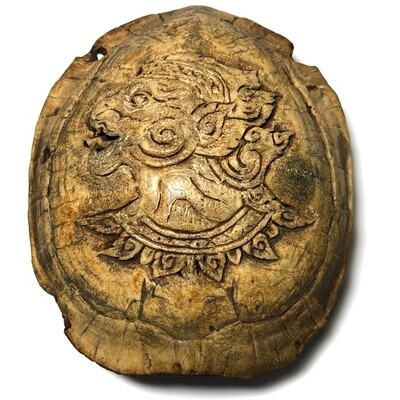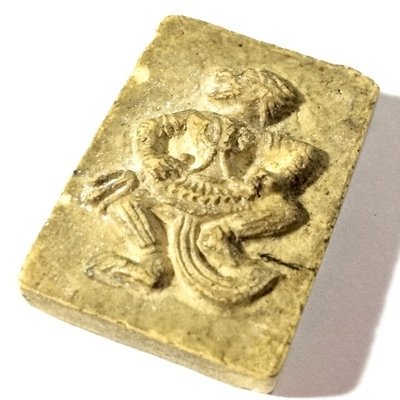Presenting a tiny but powerful and rare classic amulet from one of the Great Khao Or Masters of the 20th Century, Rian Glom Lek Hlang Chedi 2505 BE Nuea Tong Daeng Miniature Guru Monk Coin Por Tan Klai Wajasit
This Sacred amulet of the Great Khao Or Master of Nakorn Sri Tammarat, Master of Wat San Khan and Wat Pratat Noi, is a very rare amulet from Por Tan Klai’s 2505 BE Blessing Ceremony Edition, and is considered a ‘Jaek mae Krua’ type amulet (meaning ‘give to the kitchen maids and temple helpers’), which is suitable not only for men, but due to its miniature size, a perfect amulet for ladies or children to wear.

Rian Glom Lek 2505 BE Por Tan Klai Wajasit Wat Suan Khan
The 2505 BE edition of amulets of Por Tan Klai, is a highly preferred edition, which saw his famous ‘Rian Glom’ round Monk coin amulet with Chakra released, The Rian Glom Lek Hlang Chedi, and the Roop Tai Por Tan Klai Guru Monk Blesséd Photographamulets such as look om chan hmak and ya sen tobacco balls, and sacred powder amulets of various models.
A very rare and highly prized amulet for the devotees of Por Tan Klai to associate with his image and pray to him with a blessed image of the Guru, and the Chedi Relic Stupa on rear face for Buddhanussati and Marananussati. A powerful and Sacred amulet which has passed through the hands of the Guru and been blessed by him.
Por Tan Klai was one of the Top Guru Master Monks of the Last Century, and is considered one of the Four Great Masters of the Previous Generation of Lineage Masters of the Khao Or Southern Sorcery Lineage.
Kata Bucha Por Tan Klai
Hanuman Mai Gae Hnaa Krabi Ongk Kroo Ud Krang Sord Takrut Circa 2450-70 BE Luang Por Sun Wat Sala Gun
Hanuman Rueang Rit Mai Gae Pim Hnaa Krabi Ud Krang, early era Sacred Carved Holy Tree wood amulet of the Great Luang Por Sun, of Wat Sala Gun, with sacred Krang Putsa, and silver Takrut inserted into the base. Considered the number one Hanuman amulet and member of the Benjapakee Krueang Rang Talismanic amulet top 5. Luang Por Sun, of Wat Sala Gun was known as the Grand Master of all History for Wicha Hanuman, and his carved Hanuman amulets are considered the most highly sought after and desired of all history. This exhibit is a first series made from the two famous sacred trees grown by Luang Por Sun, and is a special versiion Pim Hnaa Krabi model, with sacred muan sarn filled base.
The Hanuman of Luang Por Sun is included within the officially accepted classic top 5 'Benjapakee Krueang Rang' type oftalismanic amulets and animist charms category of Pra Niyom Master Class amulets. The Hanuman amulets of Luang Por Sun are considered to be empowered with the most powerful protection magic, as well as for its Metta Maha Niyom Mercy Charm and ability to seduce and entice others into obeying.
Below; The base of the amulet is stuffed full of Krang Putsa paste for Maha Lap Maha Pokasap, and sacred powders of Luang Por Sun.
The Hanuman of Luang Por Sun came to be known as "Khun Krabi Wanorn" (Lord of the Vanora), and is considered number one Hanuman amulet above the Hanuman of Luang Por Ding (Wat Bang Wua). Just as it is known worldwide that the Master of the tiger tooth amulet is Luang Por Parn of Wat Bang Hia, it is also equally known worldwide, that Luang Por Sun was the Grand Master of Wicha Hanuman of all time. It is extremely difficult in this Era to encounter an authentic carved Hanuman of LP Sun, which are found made from carved sacred woods, and in bone and ivory.
Luang Por Sun Jantachodti, or, 'Pra Atigarn Sun', of Wat Sala Gun, in Gao Gred Nontaburi Province, was born with the name 'Sun', and was a local inhabitant of Pak Gred in Nontaburi.
There is no official biography in existence to be found on Luang Por Sun, but judging from the year of his passing, and his trajectory, one can assume he was born sometime around 2403 or 2404 judging from the few small pieces of documentation available. He was given the ordained name 'Jantachodti'.
Stories which are known about Luang Por Sun have emerged through the local aged Looksit of Nontaburi, such as the fact that during his early times as a monk, he was known to have planted 2 kinds of trees around his Kuti Hut, one being the Dton Put Sorn (concentric Buddha tree), known for having an inhabiting magical powers of Buddhakhun Power, and the other being the Dton Rak Sorn, known for its Magical Maha Sanaeh Power and Inhabiting Deva Spirit. He wouldcare for them with great diligence, as if it were a part of his daily focused meditation (Right Concentration in every moment, one of the 8 factors of the Noble Eightfold Path).
He raised both trees until they were fully grown, and after he was elected to become Abbot of Wat Sala Gun, Luang Por Sun realised that he had been inspired to grow the trees under some mysterious influence, that he was supposed to use them to make sacred amulets. He Then began to perform ceremonies and invocations over time to develop and prepare to make this first edition of amulets, and then uprooted the trees and laid them out to dry in preparation for carving. He then called upon his top artisans, and other devotees to come and assist in the carving of Hanuman images made from the sacred treewoods.
Once the amulets were all carved, he placed them all inside a white cloth and into almsbowls and took them all into his Kuti Hut to empower over time. On auspicious Lunar Saturdays, he would take the amulets into the Uposatha shrine room to empower and perform chanting seated upon magical weaponry. He would repeat these empowerments until the Hamuman amulets eventually began to jump around of their own accord within the alms bowls, which gave LP Sun the signal that the empowerment and invocation, and reanimation spells were complete.
He then began to hand them out to devotees who came to make merits over the years,. Some Hanuman amulets are found made in other substances such as Mai Po Bodhi Tree wood, and Nuea Nga Carved Ivory (which were made after the first edition using the two trees planted by LP Sun, and classed as 'second edition' but are in truth a series of amulets which were constantly carved and handed out continually over decades, and have different ages for this reason, which is visible by patina and expanding of crevices).
The Ivory Hanuman amulets of LP Sun are sepcially favored by richer devotees for they carry a high price, and are extremely renowned for their beauty and magical power of Maha Amnaj commanding power from the Ivory of the Elephant adding Status Increase magic to Hanuman.
Officially when regarding the Hanuman which were carved by the official artisans, two different major models were created; The Pim Hnaa Khone (Khone Mask Model), also known as 'Hanuman Song Krueang' and the Pim Hnaa Krabi, which is less decorative and is wearing less regalia.
Kata Hanuman (given by Luang Por Sun for his amulets)
NA MANG PLERNG MOE MANG BPAAG GRABORK YA MIHAI ORK UD TANG TOE UD TANG AD A SANG WI SU LOE BU SA PU PA MA A U OM YA PUT TAA TA YOE SA DTREE NI SANG HOE
There was once a soldier devotee of LP Sun, named who visited the temple to make merits during the time of the change of rule around 2475 BE. Luang Por Sun gave General Prayaa Paholapohayuhasena a Hanuman Hnaa Khone, and said 'within a very short time a dangerous object will fly safely past you'. After leaving the temple, there was an incident where the officer was in a shootout in the coup, and the bullet flew past him without hitting him. This cause the Hanuman of Luang Por Sun to become bvery popular and bring soldiers from the regiment to the temple as devotees of Luang Por Sun by the hundreds.
Because the Hanuman Mai Gae wooden carved amulets of LP Sun are so rare, and expensive, one must refine one'es eye to be able to define a truly authentic exhibit, by beginning with thinking about or looking at a tree trunk whose wood has been laid to dry over time, and how the wood will contract and become harder and dense, but lighter through moisture loss. If it has been worn a lot then it will be oily shiny in appearance, and if kept as Bucha on the altar will be lighter in color and drier surface texture.
As far as the ivory Hanuman carved amulets of Luang Por Sun, one defines them by 1. design factors 2. age of ivory (if reaches the Era of LP Sun), and 3. Patina (can vary if worn against skin for over ten years or more, or never worn, or in casing - one which have been against the skin for ten years or even many decades will have a much more yellow or brownish patina, or ochre).
